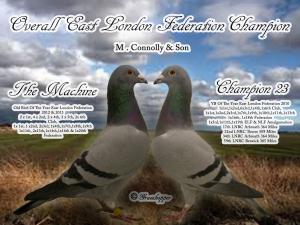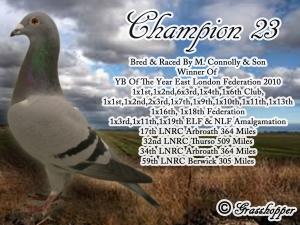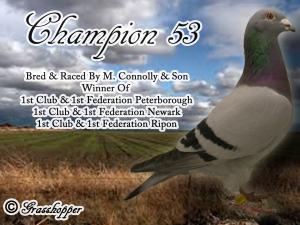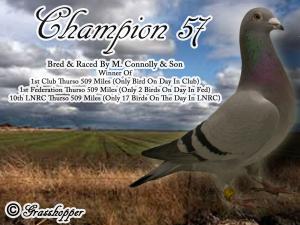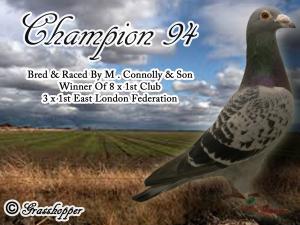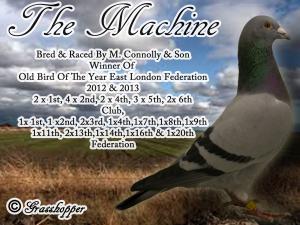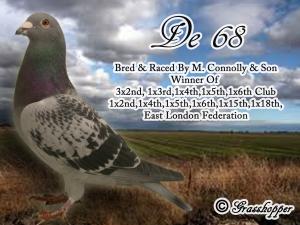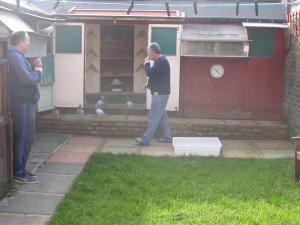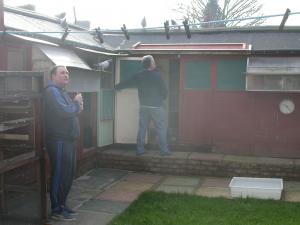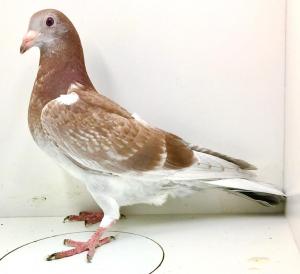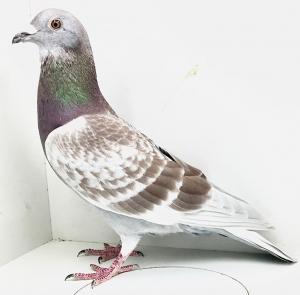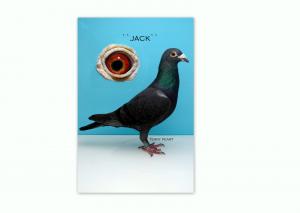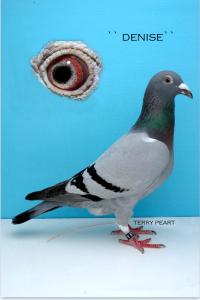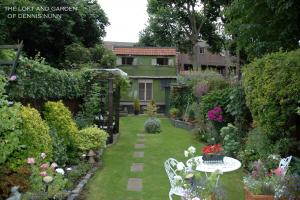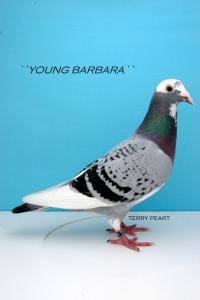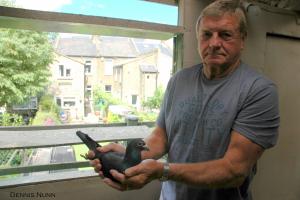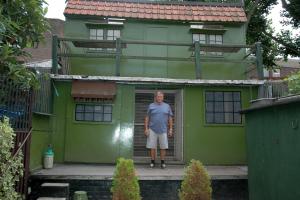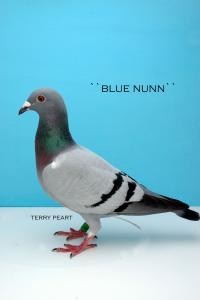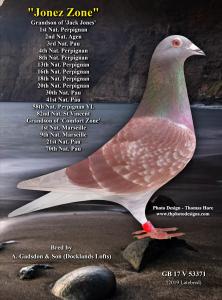
Wiley
Gold Member-
Posts
6,955 -
Joined
-
Last visited
About Wiley
- Birthday 06/16/1989
Profile Information
-
Gender
Not Telling
Recent Profile Visitors
42,742 profile views
Wiley's Achievements

High Ranking (7/8)
-
Wiley started following Where have all the pigeon fanciers gone?
-
Where Have All the Pigeon Fanciers Gone? In the sprawling metropolis of London, a once-thriving tradition of pigeon racing is slowly fading into obscurity. As I wander through the streets of East London, an area once teeming with dedicated pigeon fanciers, the lofts stand empty, and the skies no longer hum with the rhythmic beats of racing wings. The decline is evident on both the North and South racing routes, raising the poignant question: where have all the pigeon fanciers gone? The sport of pigeon racing, with its rich history and community spirit, was once a cornerstone of London’s cultural fabric. Pigeon fanciers would meticulously breed, train, and race their birds, forging bonds that transcended generations. However, the changing times have not been kind to this cherished pastime. In an age where technology drives every aspect of our lives, the sport has struggled to keep pace, particularly in London. One of the most significant innovations in pigeon racing has been the advent of electronic timing systems. These systems, which automatically record the precise moment a pigeon returns to its loft, have revolutionized the sport in many parts of the world. They offer unparalleled accuracy, reduce manual errors, and save time—benefits that should appeal to both seasoned fanciers and newcomers alike. Yet, in East London area, there remains a noticeable reluctance to embrace this technology. Many fanciers continue to rely on traditional, manual timing methods, a practice that is not only time consuming but in many cases due to its limitations, does not give a true reflection of a race result. This resistance to change is symptomatic of a broader issue facing the sport: an aging population of pigeon fanciers. The older generation, steeped in tradition and perhaps wary of new technologies, has not transitioned to the modern systems that could simplify their involvement in the sport. The question then arises: could the adoption of these systems have prevented some from abandoning the sport altogether? However, what is refreshing to see is that a small number of youths from Eastern Europe, mainly Romania with some Polish, are very keen on pigeons. Encouraging more of them to take up the hobby will help rebuild the sport's strength in this area. These young fanciers bring a fresh perspective and a willingness to embrace modernisation. They are particularly fond of electronic timing systems, especially the new Benzing Live system, which aligns with their desire to move with the times. These enthusiastic newcomers love to race their pigeons, especially over long distances, and enjoy the thrill of a side bet, adding a layer of excitement and competition that could rejuvenate the sport. Their passion and modern approach could serve as a catalyst for change, bridging the gap between tradition and innovation. By supporting these young fanciers and integrating their modern methods, the pigeon racing community in East London area can create a vibrant, sustainable future for the sport. What is frustrating to see is that although these clubs in the London area get smaller and smaller in membership and birdage decreases, clubs will still be picky on any opportunities for new membership. This selectiveness in a time of decline seems counterproductive, as the sport desperately needs blood and new ideas to survive and thrive. By being more inclusive and open to new members, regardless of their background, distance or experience level, clubs can foster a more dynamic and resilient community. The decline in the sport is not just a London-bound phenomenon but a trend seen across the country. Take, for example, one of the greatest pigeon shows, held at Blackpool’s Winter Gardens. There was a time when you could hardly move for the number of fanciers attending. Nowadays, year on year, the number of attendees dwindles, leading to fewer trade stands and a less vibrant atmosphere. However, there is a silver lining—sales are reaching record prices, suggesting that there might still be life in the old sport yet. The demographic shift is stark. As veteran fanciers hang up their loft keys, fewer young enthusiasts are stepping in to fill the void. The barriers to entry, including the cost and complexity of setting up a modern loft, are daunting for many. Without a concerted effort to modernize and make the sport more accessible, the future of pigeon racing in London on both North and South is concerning. Despite these challenges, pockets of resilience remain. Some clubs and individuals are championing the cause, pushing for modernization and greater inclusivity. However, these fanciers are sometimes labeled as “troublemakers” and can be pushed out or isolated. They recognize that to preserve this beloved sport, they must evolve. There are initiatives to introduce younger generations to pigeon racing, showcasing the excitement and camaraderie it offers. Modernized clubs with electronic timing systems can provide a streamlined experience, potentially attracting new fanciers who appreciate the blend of tradition and technology. However, time is of the essence. The longer the sport clings to outdated practices, the more fanciers it risks losing. To reinvigorate pigeon racing in London, especially in the historically rich East, the community must embrace change while honoring tradition. Their may not be many lofts now, but with concerted effort and a willingness to adapt, the skies of London can once again be filled with the thrilling sight of racing pigeons. The key to revitalizing pigeon racing lies in not living in the past but rather building on its rich history while embracing the future. As we stand at this crossroads, the call to action is clear. Let us not allow this storied tradition to fade into memory. With innovation and community spirit, pigeon racing can not only survive but thrive, ensuring that future generations will know the joy of watching these remarkable birds soar. In the words of Master Po to Grasshopper, “Patience, young one. Adapt and endure.” Let’s keep the pigeons flying and the spirit of racing alive.
-
I will concentrate on the combines and the sections in the classics if it’s the way it goes mate. But I’ll be also getting some sprinters of a good friend to race too who had my best breeders
-
I’ve had 3 tosses with the young birds, 2 tosses north and 1 south. Looks like it might be back to the north, cos I can’t see channel racing much in the future, but live in hope I’ll race them both routes
-
The sale ends Sunday week mate. I can take bids via pm or you can bid directly on www.racingpigeonindex.com
-
SALE FOR DAGENHAM MARKING STATION FOR THE THAMES NORTH AND EASTERN COUNTIES FLYING CLUB With what started as a dream in 2020 a couple of East London and Essex fancier’s heads, as being in a position where people in East London and Essex could race pigeons on the south road locally soon became a reality. A marking station that started with 9 members, has grown dramatically in 1 full season meaning that the start of 2021, has seen this small acorn grow to a mighty oak of around 25 members. The membership of the marking station ranges from the Isle of Dogs as far out as the Bishop Stortford, and the membership contains many multiple London North Road Combine winners, Essex & Kent Amal winners, and even in its short period of formation UBI combine and BICC winners. However, with this huge increase it means that we have outgrown our current facilities in the Royal British Legion Beacontree club, which means that we now have to build a facility within the club grounds that can safely hold all our equipment, and also allow us to mark our pigeons away from the weather. I would like to thank the fanciers in advanced that have pledged young birds to our sale and their continuous support. Lot 1 David Hales and Duncan Goodchild, Essex: Unbelievable way to start a sale!! This loft year on year proves how fantastic it is. In 2020 with their fantastic hen Mirfar winning 1st Bicc Open Rieux Minervois 582 miles, not to mention this lofts ever increasing track record of producing marathon pigeons for others lofts Anyone interested in serious long distance racing should not let this one go a miss proven track record that is ever increasing. The loft kindly offer a 2021 young bird. Lot 2 A Gadsdon & Son, East London: Father and son partnership, past winners of the LNRC from Thurso and Lerwick, numerous times Sprint Champions of the East London Federation, runner up to Tommy Long trophy and past winners of London RPRA region awards. The partnership has bred birds to win in England, Scotland and Wales up to federation level. The partnership turned south recently and have continued their winning ways both on their mid-week, Saturday clubs and had a number of top 50 performances with the BICC within the last three seasons. They now want to set their focus on international marathon races with the BICC. The partnership kindly offers a young bird from their David Hales stock. Lot 3 B & J Wilson, Essex: A father and son partnership that have hit the ground running on the south road winning the UBI combine, and the BICC from Guernsey. This partnership has been exceptional on the North road and with a BANG their success has taken the south road by storm. Another loft with a proven track record of breeding winners for other fanciers, with their fantastic family of Soontjens. The partnership kindly offers a young bird from the stock loft. Lot 4 John & Theresa Gladwin(Formula 1 lofts), Essex: What a lot from the 2020 Golden Duif Winners!! John & Theresa have been hugely successful on the North and south road routes, winning club, federations, combines, sections, RPRA regional awards and nationals. They have also a huge representation of producing winners in many, many other lofts. In 2015 they made the great decision to buy out Frans Zwols when he retired from the sport. Since then they are responsible for 51st x 1st or 2nd national winners, via the team of Formula 1 lofts, 7 of them can be included for either John and Theresa and their partner John Cowlin. John and Theresa offer a 2021 young bird, could you be the lucky buyer to make the tally for formula 1 lofts to go up to 52 x 1st national winners!! Take your chance on this 2021 young bird offer!! Lot 5 Tony Buckfield, Essex: Mr Consistent as he is known in the sprint and middle distance scene for many, many years, as if he isn’t winning he is knocking very close on the door. Tony a past winner of the BICC and UBI combine, including another BICC win in 2020. This loft kindly offer a 2021 young bird, strike while the iron is hot!! Lot 6 John Cowlin, Essex: The record breaker, taking the first 8 positions in the mighty NFC in 2020, as well as taking the top 3 places in the BICC young bird race with 2 out of the 3 being in the top 8 in the previous NFC race, it can be questioned is there currently a better Young bird flyer in the UK? Along with John Gladwin, the other side partner in Formula 1 Lofts. John is a fantastic flyer with a lot of wins both inland and over the channel. Deadly competitor in the Thames and always one to watch, and is always high up on the result when sending in the BICC, NFC and UBI. Past winner of the BICC, and top top fancier young birds or old birds. John supports the marking station again with a 2021 young bird. Lot 7 Anthony Webster, Wisbech: Tony Webster has been a top fancier for many years back in his days in Kent, where he made his name on the sprint scene especially with young birds. BHW scribe and Dagenham marking station member wrote about Tonys achievements in 2014 when he won East London Federation sprint championship, but since then he has moved a number of times and won many many 1st clubs and federations wherever he has gone. Within the last two season he has won 10 x 1st Federation, 24 x 1st Club, 46 cards in the first 10 of the federation on a 5 bird limit. Tony is well known for having multiple drops of birds up to about 25 birds. Tony has been phenomenal and now wishes to put his success at sprint and middle distance across the channel where he has immediate success. Tony offers the sale a 2021 young bird. Lot 8 Micky Connolly & Son, East London: Must be considered one of the best partnerships in London ever, 3x1st Open LNRC, Countless Section wins in the NRCC,1st Open E&K Amalgamations, 2 x Tommy long trophy winners Unreal amount of times as Club Heightest prize winners, East London Federation Highest prize winners and RPRA London region awards. Already have a 2nd Open BICC to their name, this partnership are top draw and will be top of the tree on the south road in the near distance future. Micky and Michael offer a 2021 young bird. Lot 9 Central Lofts Eddy Butcher & Sons, Essex: This partnership has invested heavily in the best pigeons available whether short, middle or long distance. They have recently moved to deep Essex, and have started with young birds on the south road in 2019. Their birds have won throughout the UK with some really big performances in some of the biggest organisations. Eddy and the boys offer a young bird from their successful Van Den Bulcke family, being direct from the lofts best racing hen with a number of results. What more can you ask, you know what this partnership brings in each year only the best, and the partnership are offering a young bird from their best racer. Lot 10 Brian & Karen Hawes, Essex: This partnership has real legendary status in the game both North in the London North Road Combine and on the South in the UBI. Their family pigeons are known worldwide, and are responsible for 1000’s of winners. This partnership is 100% dedicated to pigeons and have won from 50 miles to 500. This partnership are new members to the Dagenham marking station, and I am sure like everywhere else they have gone in the past they will make their name known to the Thames and to the marking station. The partnership kindly offers a pair of 2021 young birds. Lot 11 John Halstead, Dorset: Probably one of the most famous pigeon fanciers in the country, not only because of his results at channel and long distance events, but also because of his very in-depth instructional pigeon videos, that I think at some point or another every pigeon fancier in the game would have seen one. Known for his great wins from Barcelona and Palamos, this top of the draw fancier has also won channel events from the shorter events too, making his title of one of his videos ‘Any distance Widowhood’ very apt. John kindly offers a 2021 young bird. Lot 12 Carbon Lofts, George Metcm, Essex: Brand new racing stud created in 2020. Basing their lofts on National and international winning lines. Their motto uses the old Geoff Kirkland phrase that the “Apple Never Falls Far From The Treeâ€, and they have invested so to represent that. At stock they house direct children of national winners, with the young bird that this loft is offering is from a direct child of the famous pigeon ‘Forest Gump Junior’ 1st International Pau winner, 28th International Bordeaux and sire of 1st International Agen for SG Freialdenhofen & Sohne of Germany. Lot 13 Steven Fenech, Essex: Exceptional record racing on the North Road with London North road combine, Essex Combine and Essex and Kent Amalgamation wins, with his team of Dennis Sapin pigeons. Now Steven has started to race on the south, and probably has the most complete collection of original Dirk Van Den bulcke pigeons in the world. This loft definitely will leave its mark racing on the south road, as they have done wherever they have raced. Steven family of birds have won globally and will only go from strength to strength, this loft kindly offers a 2021 young bird for the marking station sale. Lot 14 John Wheatcroft: John has a name that every time you pick up the pigeon papers, you see that winner after winner has been produced from his line of pigeons. John is famous for sourcing the best from Belgium, especially his family of Leo Heremans. I believe John has produced winners in every major organisation within the UK. John offers a great opportunity to purchase a 2021 young bird to give YOU the chance to add your name to the list of winners that he has produced! Lot 15 Davy Hunt & Sons, Hertfordshire: This record breaking partnership started back up again for young birds in 2020. The partnership has legendary status wherever they have raced, and have broken records in every club, federation and organisation they have ever been in. Their comeback season was like they have never been away, winning multiple 1st prizes yet again at all levels. This partnership has been top of the tree for many, many years, and it’s exciting to see Davy back in the sport. Davy has donated a 2021 young bird to the sale, this is a partnership that leaves no stone unturned a phenomenal offer not to be missed. Lot 16 John Chipperfield, Kent: 2019’s King of Barcalona, unbelievable performance winning the race into the UK by some margin. John was a top sprint flyer on the North Road when racing in the heart of east London, and when moving to kent, he has set his sights on long distance racing, and is really making the UK stand up and look with 5x1st Open BICC under his belt, and believe me it will not stop there. John kindly donates a young bird. Lot 18 Lenny Jenkins, Essex: Lenny has won wherever he has raced from, the last few seasons he has been silent partner with the very successful fancier Tony Calverly of Dagenham. The partnership clicked and saw the partnership win 1st Open LNRC Berwick but also 2 x Tommy Long trophy, which is highly sought after prize in the London area. Lenny is building a family of sticker donckers combined with birds supplemented from Ian Stafford. Lenny has kindly offered a pair of babies for the sale. Lot 19 Dale Bagge, Essex: Dale has been back in the sport for only a short time, but in that time he has won club and federation on the north road. His family of sticker donckers have been winning for other fanciers too with Lenny Jenkins doing well with the birds that Dale has bred too. Dale is offering a pair of young birds from his direct Sticker Doncker pigeons of the old lines. If sprinters are what you are looking for look no further. All bids starting at £30
-
Anyone got any info on this bird that won the Scottish national from cholet being only bird on the day please?
-
Canning Town is a district of East London. It is situated in the London Borough of Newham, and lays north westerly of the River Thames. Once known as the child of the Victoria Docks, as many of its inhabitants worked on the once hugely commercial success of its day. In racing pigeon terms we often hear how important positioning can be, and also how wind plays another vital important role. However, one partnerships remarkable team of pigeons contradict the said theories, as they are positioned in a disadvantageous position, and the prevailing wind blows in a south westerly direction. Sprint or Distance racing is no issue, as they win them both to the highest standard, in Federation and The London North Road Combine. Their performances against the grain of the said theories, in my eyes make the partnership one of, if not the best London has ever seen, the fantastic partnership of Micky Connolly & son Michael. When Micky was just 5 years old, his natural curious behaviour played a big part on how he started in the sport. His older brother Henry, at the time had a marvellous set up in the parental home, a double decker structure, where the families chickens were kept at ground level, and Henry's beloved pigeons on the first floor. Micky would regularly watch Henry’s athletes of the sky with desire in his eyes, with dreaming one day to own his own. Around this time, the family had an old empty canary cage. As many of the readers will know, toys was not a common thing roughly sixty years ago, and many things children would play with would have to be made or the child would have to use their imaginations. Micky at the time done both, with old used newspapers, he rolled up balls, and pretended they was his prized birds, and the old canary cage his loft. His older siblings would watch in amazement how he impersonated, Henry's actions of getting his birds to enter the loft. Henry was very encouraging of Micky's interest in the birds, and would often take Micky into the lofts to help with certain tasks such as feeding and cleaning. However, Micky wanted some form of independence, and regularly on a Friday evening, Henry would hit the town with his friends, allowing Micky the perfect opportunity. As soon as the door would slam shut, Micky would be up the stairs to the lofts and exercise a fully fed team of birds. Obviously that lead to the problem of the birds spending a night on the tiles literally. Being worried of the consequences, Micky would hardly sleep on those nights, and rise at the crack of dawn to call the birds in, while a hungover Henry was still sleeping. It was not until Micky was 15 years old that he obtained his own birds and applied, and joined the Canning Town and District club which at the time had roughly around 90 actual members with 60 of the members actively racing. At this time, Micky's birds were a mixture gifts from local fanciers, and strays he would catch every weekend while fruit picking near Wisbech in Cambridge. Success came fairly instantly, as within his first year he won a race with a chequer hen bred from two strays, and ended up taking 4th federation. When Micky was 22, he was still living and racing pigeons at his parents address, unfortunately the family had to move during the season. Not deterred, with his race team sitting and rearing young birds, Micky went ahead and moved his birds to the new address on the Tuesday morning. On the Wednesday, Micky attempted to brake the birds in, consequently all birds returned to the previous address. One by one all birds had returned back to the new lofts address by the Friday, just in time and ready for marking. That first race to the new address was a disappointment, but the following week the birds excelled topping the club with around 700 birds, and winning the federation with 4,000. Micky, moved to his present address roughly 30 years ago, while still being a member of his childhood club Canning Town. It was not until roughly 18 years ago that he joined his present club, The Custom House Working Man's Club, that had a huge reputation of having some of London’s finest competitors, especially at combine level. Consequently Micky, has broke many records over the years that the club has held and has even set his own. Young Michael's interest in pigeon, started much like the majority of the youth involved in the sport today, by following and helping his father, in and around the lofts from a very young age, and has had a love for the birds ever since. As can be seen Micky, has never been far away from the top of the sheet, and has never positioned lower then third highest prizewinner in any club he has raced in, it should also be mentioned that this partnership have amazingly won the London North Road Combine on two occasions. In the early days, Micky received a lot of help and advice from two fanciers Lenny Croxon of Canning Town, and he was very good friends with Jack Marison of Plaistow. Mick stated their advice was brilliant at the time, but especially over the last twenty years the sport has transformed, and many of their beliefs are behind the times. Mick also believes that you must always be one step ahead of the competition, and you must constantly progress. Mick feels that Young Michael adds that influential ingredient, by always bringing fresh ideas to the table, which they put into practice with great success. The base of the family originate from Staf Van Reet of Mol, Jan Hubrechts via Herman Beverdam, Benny Brothers of Plymouth, Henry Gonsalves of Bristol and more recently, Billy Lynch of Romney Marsh, and Paul Elliot of Canvey Island. Micky, is convinced that their results over the last 10 years have elevated due to their breeding system. A few years ago, their system of breeding consisted of having a winner, in every generation over 5 generations. More recently they have improved this system, by raising the winning genes, meaning both parents in each generation are winners or multiple winners. Micky and Michael are enthusiasts of the line breeding and inbreeding methods, however the occasional cross will be used to create hybrid vigour. They have found their most successful birds generally come from the mating of, Uncle to Niece, Aunt to Nephew, and Cousin to Cousin. The selection process when bringing in a cross, is the bird itself must be a multiple performance pigeon or from a multiple performance pigeon. They consider introducing new birds into their lofts is a big risk. Being a small team set up, every bird must instantly mingle with their own family of birds, they do not have the room or facilities to quarantine new arrivals, hence threatening their birds natural immunity. What is most interesting about this loft, no stock birds are kept, every bird kept must race and perform, as the key to their successful breeding method is breeding from good, healthy winners, and being extremely ruthless in their selection. The success of the family of birds has been remarkable, over the last 5 years, they have achieved 32 x 1st club, 34 x 2nd club, 36 x 3rd club, 21 x 1st fed, 10 x 2nd fed, 15 x 3rd fed, as well as 200 plus federation cards. To add to this they have been Overall East London Federation Champions 4 times, Sprint Champions 2 times, and Old Bird of the year 5 times. In 2012 the partnership won 7 out of the 10 special trophy awards given out by the federation from sprint to long distance. In 2013 the partnership won 8 out of 10 of these awards also. They are also extremely successful in the London North Road Combine, where they have won over 54 combine cards, as well as the coveted Tommy Long Trophy in 2012, awarded for the Best Average over 3 Old bird London North Road Combine races, as well as winning 3 RPRA London Region Awards. The best preparation in this partnership's eyes prior to pairing, is to never allow your breeding or racing pigeons to get out of condition. Their birds are exercised all year round, and are never allowed to put on any winter weight, with regular exercise and by feeding a constant diet of Versele Laga Gerry Plus IC throughout the year. The use of medication is a thing of the past at this loft, apart from the compulsory vaccination they have not used them for a number of years. Micky stated, that many years ago he experimented with regular canker treatments, and by doing so, he found that his birds suffered with canker problems. However, once he stopped treating for canker, the canker problems ceased. Consequently, they are big advocates of the use of cider vinegar and garlic, which they place confidence in at keeping canker issues away, and is something they use a lot of especially in the winter months. While pairing and racing the use of clean water, the partnership feel is crucial to their success, and gives them the edge over their rivals. They feel one of the major downfalls of their opponents, is believing that success comes from a supplement bottle. Many fanciers disregard the importance that water has on pigeons, by energizing the muscles, removing toxins, improves brain function and helps maintain natural bowel functions. They believe a pigeon should have no hesitation about drinking, and should hydrate as they please, which they feel is very important all year round, especially during racing and rearing. As stated the birds are fed Gerry Plus IC, and this will be used until the birds are roughly a week old, to which they will be moved onto Versele Laga Start Plus. They consider the Versele Laga Plus ranges to be the best grain on the market. They feel Versele Laga have put great deal of research into producing these mixtures, and the pellets they contain, provide the birds with all the minerals and trace elements that a pigeon need to be successful. On the other hand, when the youngsters are 10 days old, they give the youngsters Brewers Yeast tablets and Cod liver oil capsules to provide the babies with extra protein, B vitamins, Vitamin A and Vitamin D. Once weaned the 15 pair of racers are put back onto Gerry Plus IC, and are separated and put on to the Widowhood system, and are exercised twice a day. The morning exercise, consists of the birds being exercised with the doors open, and the birds can come and go as they please. Their evening exercise, is known at the lofts as the business hour, where the birds must give all their effort. At the hour of business, Young Michael, has to hide in the lofts away from sight of the widowhood cocks, as once they catch glimpse of him, they will dive bomb the lofts and trap into the lofts without a second thought. The birds are never allowed out for exercise on a marking day, as they do not want to ruin the hard work they have put into the birds all week. As they race both sexes, they keep a dozen spare hens at home, to which the cocks race back to, however the partnership feel the Old hens race back to themselves, as many of the old hens pair to them. Many years ago Georgie Fry of Custom House, provided the partnership the cornerstone of their success, a metal coffee spoon, which roughly holds half an ounce of grain. All birds housed at the loft are fed and watered exactly the same, whether that be Old Cocks, Old Hens or Young Birds. Their system starting from return from a race on Saturday, is 1 spoon measure of Versele Laga Energy Plus, with plain water in the drinker, unless the race has been testing, if so glucose will be used in the drinker. Saturday evening the birds are fed ad-lib Gerry Plus IC, fed a little bit at a time as they want their birds to eat every grain placed in front of them. All day Sunday, a hopper of Tic Beans is placed in front of the birds, they are given a Brewers Yeast Tablet each and Cider Vinegar is used in the drinker, 4 bottle caps to 2 litres of water. The reasoning behind the feeding and Brewers Yeast tablets, is to increase the protein levels of the birds, the partnership feel it is very important that when muscles have been torn, which they do with every form of strenuous exercise, that the birds should receive the right nutrients to allow the muscle to repair. The Cider Vinegar is used to acidify the crop, and making it unpleasant for any bacteria or fungus that they may have picked up in the race basket. From Monday to Thursday the partnership then go onto feeding only once per day after the evening exercise. On Monday morning, the hopper of beans from the previous day is removed. Then after the evening exercise the birds are fed 1 ounce of Gerry Plus IC, and again Cider Vinegar in the drinker. On a Tuesday and Wednesday the feeding is exactly the same as Monday, 1 ounce of Gerry Plus, however in the drinker only plain water is used right through to basketing. The feeding changes somewhat on a Thursday, as after their exercise the birds are fed, 1 and ½ ounces of Versele Laga Superstar Plus. Friday morning, the birds are fed to appetite of Superstar Plus, a little at a time always having to eat the portion put before them. However the partnership stated, that over the years they have found the birds that keep on eating are usually behind come race day. The partnership do tweak the system when the distance increases. A pinch of homoform will be used before the birds feed and the use of peanuts are fed 3 weeks prior, however no peanuts will be used the week of the race. The watering system caused interest, as the water is kept in a series of recycled Milk Bottles, once used they are refilled with the cap taken off, to allow the tap waters additives to evaporate. Their system for basketing is very simple, nothing special is actually done, no showing of bowls or hens/cocks, the basket is just taken down to the lofts and the birds are basketed. The birds only see their partners on return. Micky and Young Michael are big believers that widowhood cocks do not race home to see their hens, they believe they race back home to their territory. However over the years and by reading so many books on widowhood, they go with the motions of what the authors say, hence the reason for keeping a few spare hens. The partnership believes, the cocks are motivated during the week by the use of Saddle perches positioned in-between the widowhood boxes. Micky says, that when transferring the young cocks to the widowhood loft, generally there is only lower boxes available, but the younger cocks take up a higher saddle perch, where they sit and wind up the older cocks in the higher boxes. In the past a motivational trick they used to bring out a big result was jealousy, where they would basket up all the cocks going to the race, then move over the hens and allow them to sit in their bowls in the cocks section. They would then put some rank cocks in with the hens. Once the cock was down low calling, and all cuddled up, they would release the racing cock back to his box, and all hell would brake lose. Micky said this method of motivation, was excellent but it would not work on every pigeon and it is something you could only do once a year, and he has moved on from this way, as he likes his birds to go to the races calm, and to rest in the basket. The babies are raced on the darkness system, and are placed on the dark at the end of march, although they are not placed on the dark straight from weaning. Instead the young birds must show self sufficiency before being placed on the dark, they must be eating, drinking and perching before being placed on the system. Micky feels it is important that the birds must find the drinker themselves, they will never dip a young birds head into the drinker, if they cannot find the drinker themselves, they will never have a place in the team. During this stage the birds are fed Tic beans for roughly 7 days, to make sure the birds get used to eating large grain, from then on they are placed on the stable diet of Gerry Plus IC. Once put on the darkness the birds are only left on the system for a period of 6 weeks, the reason behind this, is to ensure the young birds have a perfect moult and are not holding any nest flights at the yearling stage. The lofts that the birds are kept in is never completely black, it is best described as a moon lit night, however the ventilation in the lofts is excellent, and all ventilation holes are never blocked in and the birds have roughly 8 hours of light a day. What should also be stated is the young birds are the only birds trained at the lofts, at and only at a distance of 30 meters, on a green at front of their property. Obviously from this distance, it is only to school the babies to trap, and they will be taken here a number of times a day until it is stuck in their heads, that they must come over the roof and in. The young birds are only trained at this distance as nobody in the partnership or family drives, but they proved roughly over the last 8 or so years training is not essential to be successful. At the end of young bird racing, and to kick start the moult, the partnership will not feed the babies for 2 days and will put garlic cloves in the drinker, as well as being put on lock down for a period of two weeks. To also assist with the moult the partnership will feed Gerry Plus IC, along with Energy Plus IC to provide oily and fat based seed which are beneficial for the moult, as well as the use of regular baths. Micky and Young Michael both feel, that novices should always listen to pigeon fanciers, and they should always pick the bones out of what they say. They feel novices can benefit by sticking to a routine, and not changing their system just because they are behind or they liked what was printed in an article. Both members of the partnership admire the performances and results over the years of Henry Blaker of Canning Town, who at one time was one of the best fanciers in the London North Road Combine, and Billy Lynch of Romney Marsh, as he was a fantastic flyer who was hard to beat in every race he competed in. They also admire every single member of their club, as stated earlier in the article, as each and every member is highly competitive and top draw fanciers, proved by how many years the club has won the East London Federation shield. One club member, they are very grateful for his help is Tommy Devlin of Canning Town, as without his help to get to and from the club, they would struggle to be able to get to and from the club. Micky and Michael aims for the future, would be to join the North Road Championship Club, and one day they hope to go south road, for their longer distance ambitions. What does this fantastic partnerships future hold, to be honest, Micky's favourite song describes it perfectly “The Only Way Is Up†Grasshopper
-
Grasshopper Goes Hopping Down In Kent, In 2014. “There are men in the village of Erith that nobody seeth or heareth, And there looms on the marge of the river barge, that nobody roweth or steerethâ€. This extract is from the famous poem 'Erith on Thames', and its subject is a district of South East London, with a Kent Post Code, called Erith, which is situated between Bexelyheath and Dartford. However, the racing fraternity in the East London Federation, and New Eltham Social Flying Club, both 'seeth and heareth' about one man's results with his family of pigeons. It would have been extremely difficult for anyone not to notice someone clocking up seven first prizes in his club, and four federations wins. To add to these achievements he was also crowned premier prize winner of his club, and the prestigious title of 'Sprint Champion of the East London'' Federation'. Hopefully by now, the hints just like the river Thames has directed you to one source, Anthony Webster. Anthony’s family have always been involved in some shape or form with racing pigeons. His fathers uncle, was a very keen pigeon fancier who raced out of West Kingstown in Kent. His mothers, parents were butchers, and they raced their birds behind their shop, which they owned and worked at. Anthony grandfather was a successful loft manager for Harry Derbyshire, of Bexleyheath. So, as you can see Anthony, had many fanciers in his close family that if he wished, he could rely on for help and advice. However it was not until 2004, that his parents decided that they would obtain some pigeons for themselves. The pigeons they first started with originated from Louis Massarrella's Kirkpatricks, and gift birds from Kathy and Ray Woodley. To put it bluntly success did not happen overnight. On the other hand, when Anthony’s parents had started, young Anthony had no interest at all. It was not until 2006, that Anthony piped up with a quote to his father “Even I can beat youâ€.This sparked the competitive flame, in his fathers heart. Anthony was duly gifted a compartment, to obtain his own birds and to back up his own claim, however they would still race under the family name. Anthony approached two fanciers Kipper Taylor of Rochdale, and Steve Surrey of Wisbech. From Kipper, Anthony purchased the family of Stef Van Reets, and from Steve, he bought the family of Van Loons. Results changed instantly with Anthonys interest, and his fathers new found competitive flame. In-fact, in Anthony’s first race he competed in, he finished second to his father, but that may have been something to do with the clock, positioned in his fathers compartment. At around this time, Anthony's best pigeon was actually bred by Steve Surrey, and was named the 'P ring cock'. Anthony was extremely pleased on how this cock performed for him in the early years, as out of the thirty one races he was sent to, this game pigeon won twenty six prize cards. Including winning all pools in the Orpington and Footcray club, consecutively for six weeks running. Kipper Taylor’s favourite saying in the early years to Anthony was “If you lay in bed, you wont top the fedâ€. This is something that has stuck in Anthony's head, and he swears by this quote today. One thing he also picked up from Kipper's regime, was how important training pigeons is. Kipper in Anthony’s own words was one of, if not the hardest trainer of pigeons he has ever known. Consequently, Anthony is an extremely hard working young man, working from six to seven days most weeks. However, with Kipper's words stuck in the back of his mind, he rises every morning much earlier then need be, to attend to his birds and to try and get the best from them. Anthony's performances year after year, improved steadily. 2013, was a golden year for him as described earlier in the article. Anthony's family of birds have changed somewhat, from the families he first started in the sport with. When obtaining his modern day family of birds, the main thing he took into consideration was how little patience he has, so he decided long distance racing would not be the best route to go down. His main priority, when purchasing the birds was if he could not buy the champion, he would only obtain direct children, if they was not available he would leave his interest behind. The family of birds he built up, were from some of the top sprint names, from the region of Berlaar, in Belgium, such as Carl & Cyriel Lambrechts, Vandenbrande Brothers, Gert Heylen, Frans De Mayer of Kessell, and Frans Laeremans of Putte. Like all of Anthony's birds, his breeders receive no medical treatment until after the moult has been complete. Around the time of the end of October, beginning of November, Anthony will give his breeders a ten to fourteen day treatment for paratyphus, with a medication of either Parastop or Baytril. He is a keen believer, when pigeons are treated, they are not treated with the same product everytime, as he does not want the birds to become immune to its ingredients. After the paratyphus treatment, his breeders then receive one days of clear and clean water, then three days of multi-vitamins and extra minerals. They will then be left, with no treatments, until the birds are sitting eggs, were Anthony feels it is important to treat for canker. The breeders will then not receive any treatments, until after the next moult, and are on clean water for the rest of the year. Anthony is a big believer in natural resistance especially for his breeders. Interesting Anthony, never cleans his drinker, the water is just topped up with a jug. His breeders are fed during the whole year Versa Laga Best All-rounder, apart from when rearing young birds were they are fed Countrywide No.1 mixture, which consists of Beans, Peas and Tares. Anthony changes his feed, while rearing as he believes this mixture helps to bring his young birds on, to grow big, strong and healthy. Anthony stated, that any of his breeders that fail to cope with breeding and rearing four rounds are removed completely from his lofts. Anthony races his old birds on his own adaptation of the roundabout system. His old birds are never exercised during the winter period. While moulting his racers are fed the same as his breeders, Versa Laga Best all-round. However he uses some supplementation to help and assist with the moult namely, garlic oil, ground nut oil and poultry spice. Anthony’s race birds, are not mated until the first of march. But what should be noted there is no treatments prior to pairing. The first treatment the birds receive is while they are on eggs, which will be with a four in one, to ensure that the parents are one hundred percent healthy before the eggs hatch. The birds as stated earlier are not flown at all during the winter, and their first exercise starts once the majority of the hens have laid. However, it should be stated that the birds are only let out on nice, clear days and they are never forced to fly. Once flying good and strong around home for roughly fourteen days, Anthony will then basket the birds for road training, always remembering his friends Kipper's words. The birds are kept slightly hungry, for the first two days of training tosses. The racers are taken two miles, ten times a day, for two consecutive days. Which sounds extreme but is done for to install into the birds heads that they must trap quickly and effectively. After the first two days of training tosses, the cocks and hens are trained separately at the breaking point of 16 miles, cocks in the morning, and the hens of a night. Once the young are weaned, and the cocks are on the drive again, the birds are trained in pairs, with the cocks chasing his hen home. The birds will then be separated before the hen has laid. Anthony does not like the cock to see a hen lay her second round of eggs. All of Anthony's race birds are fed at three periods during the day, first at six in the morning, four in the afternoon and, at eight of a night. Each period of feed is generally of a half ounce measure. Anthony also feeds on a feed table, which is at chest height, positioned behind his speed traps, which also encourages quick trapping. Starting with return from a race on a Saturday, the birds are not fed on immediate return, they will be fed on return from the club, and are fed D-200 from Versa Laga, which is a diat mixture of roughly one ounce of corn. On the grain Anthony uses, protein powder of the whey and casein type, which are fast and slow reacting proteins. Anthony would also put in the drinker a product called Gerdon I which provides the birds with essential trace minerals and elements. No birds will be let out or trained until Tuesday evening, another thing Anthony, believes in is complete rest. On a Sunday, and a Monday, the three feeds the birds receive is with the same diat formula from Versa Laga, with protein powder added again to the grain, however nothing is added to the drinker. On a Tuesday morning, the birds yet again receive D-200, it is not until the afternoon when the composition of grain is altered. At the times of four in the afternoon, and eight of a night, twenty percent of Cribbs maize will be added to the D-200. On a Wednesday the percentage of Cribbs maize is increased again, this time to thirty percent, yet again plain water. On a Thursday, the Cribbs maize is upped to forty percent, again fed alongside the D-200. However on the last feed at eight, if the birds eat all the grain put in front of them the birds are offered only Cribbs maize, and can eat as much as they like or until they have had their fill. Yet again they receive plain water, Friday the birds receive no feed and in the drinker is plain water. The only time the feeding system is adjusted, would be due to the distance of the race point exceeding one hundred and sixty miles. In this case, Anthony adds palm oil, garlic oil, and ground nut oil to the last four to five feeds, to increase the fat storage levels of the birds. As stated in Anthony's system, the birds receive no feed on a Friday, genuinely Anthony does not even go to the lofts until returning home from work at roughly three in the afternoon. Anthony attaches weight on basketing his race birds as early as possible, as he is of the opinion, the earlier you basket, the better the birds trap on race day. His basketing routine, would be to give the cocks the bowl, for up to one hour, while he takes his time to basket his hens. The cock birds are never locked in with the bowls, but once the hens are basketed, the basket is placed in front of the lofts wire doors, so the hens can see the cocks, going backwards and forwards to their bowls and calling their hens. Their roles can sometimes be reversed, with the cocks seeing into the hens, but it is truly dependant on the race point. Once both sexes are basketed, they will then be placed into the car or van, with a blanket over them for around one and a half hours, so they go calm to the club. Their is nothing Anthony, dislikes more then overexcited cock birds. Anthony's watering system, is very basic and natural, with receiving only one supplement in the drinking water all week, on return. However Anthony will use medication a week before an important race, whether that be an Essex and Kent Amalgamation or a London North Road Combine race. These treatments will be rotated, whether it be a wormer, 4-1 treatment or treatment for canker. A motivational trick, Anthony likes to use for good results, is placing a bird in a strange environment for three days. Ideally he likes to place them in a position where they can see their lofts but cannot get to it. When in this position the said bird, is never allowed access to their lofts, they are under lock and key with complete rest. Anthony likes them to see their loft mates out, and about and enjoying themselves. As well as being removed from the lofts, they can see the fun their friends are having, Anthony believes this helps fuel the motivation. Anthony prefers a good racing hen over a racing cock. He believes the hens are not easily lead like cock birds, they are always focused on the task at hand and the recover rate is phenomenal. Anthony’s feeding system for his sixteen pair of cocks, hens and forty young birds is exactly the same, though their training methods differ slightly. Anthony’s mindset is that youngsters must be trained at nine weeks of age. They start of at two miles, to which they go a period of six times. They will then be moved on to five miles, but interestingly at this stage they are taken five miles at every point of the campus, approximately two times each. Afterwards, they are taken back onto the line of flight, at eight miles, twelve miles and then sixteen miles, twice a day. However at these stages, they are only pushed on once they leave the baskets straight away without any circling. When quizzed on what piece of advice he would give a novice looking for success, Anthony stated what he was about to say was harsh but, he swears the worst mistake a novice can do is accepting gift birds of club members. Although it would be the cheaper option to get started in the sport, he insists it will put the fancier back for years. He suggests the best option would be to save your pennies, do some research and invest in late breds of multiple federation winners, and breed of them. There are three fanciers that Anthony, really admires in the sport today. Those being Ken Salt of Derby, Arthur Farrar from the West Midlands, and Colin Fagg Of Kent. Anthony swears that his success is down to the help and advice that Ken, has offered him. Anthony says that Ken, transformed his results in only one season, transforming him to an average flyer to premier prize winner He is also very thankful to Arthur, as it is through Arthur’s birds, that Anthony bred 'Best young bird of the East London Federation. Anthony is also truly grateful to his very good friend Colin for his help and advice for races over two hundred miles. In conclusion, I would like to thank Anthony, and his family for their hospitality while I was at their home and lofts, and I would like to wish them the best of luck and good health with their expanding family, and wish them all the luck for the forthcoming racing season. The above was written in 2014 and myself and Tony continue to be good friends, he has moved further up north now and has continued his success in club, fed and midlands national. Grasshopper
-
He sells ybs normally at Blackpool never heard of him otherwise oh and he makes nest boxes, never seen him in a result
-
Pigeon fancier question..... Would there be any interest in a Breeder Buyer with a twist? Same way as a breeder buyer however, it is run over 2 races in an organisation? So the bird must be sent to both races and timed, and the best average over the two races decides your winner? What's your thoughts could it work? An inland race and a channel race?
-
On this cold, wet and windy Saturday morning I spent it round my good friend Duncan's taking some photos of the lots for the upcoming sale on behalf of Dave Hales and Duncan Goodchild on the 19th November . These two sons of the Super Dave's Diva, when she was paired to two top racing sons of the Immortal Champion Tubby really stood out and took my eye. I am no professional photographer so I probably have done the pigeons an injustice, but for me they had everything in a pigeon you could ask for.
-
Grasshopper Hops Back To The Past Stepney is a district of the London Borough of Tower Hamlets, and is situated in London’s legendary East End. Stepney’s foundations stemmed from a medieval village that grew around its famous St Dunstan's Church, where the bells that hang in its belfry are mentioned in the nursery rhyme 'Oranges & Lemons'. Many elite fanciers to sprout from this district, but regarding the fanciers winning the prestigious Tommy Long Trophy, the powerful bells kept ringing the same rhyme “When will that be, says the bells of Stepneyâ€. In 2013, one of Stepney's indigenous children stepped up to the plate and silenced the bells, to be crowned king of the London North Road Combine and against all the odd that pigeon racing places. However unlike most coronations it was not through a Line of Successions, to be seated at the London North Road Combine throne, but by the will, power and performance of two of his monumental Dames, to arise as King Dennis Nunn of Stepney. It could be said that Dennis' was always set up to be a fancier, as for all his life he has been surrounded by pigeons. Dennis' late father, raced pigeons before and after the war, and Dennis' brother Tommy also raced. Dennis' interest really started when he was gifted some fancy pigeons while he was still in full time education, and this is where he learnt the essentials of care and observance in pigeon keeping. After a number of years, Dennis got married to his wife Barbara and moved into there marital home and was only without pigeons for a very short while. It wasn't until Dennis nephew asked if they could obtain some Show racers, to which Dennis obliged and once a team was established the 3 years they presented the birds at shows they were highly successful. Then in 1970, Dennis' journey in pigeons took a different direction, persuaded by his his brother and a number of cousins, Dennis took the plunge into the racing fraternity and joined the very big Stepney Green club. Success was instant, as it could be said Dennis' dominated the first two races he competed in, taking 1st, 4th and 5th the first race, 1st 2nd and 4th the following week, in a club with huge membership and enormous birdage. At this time Dennis first birds were Janssen's from his brother Tommy and pigeons from Freddie Clayton of Red Flash Black Flash Fame. In the 70's Dennis like the majority of fanciers only raced natural, and his employment at the time enabled him to train his natural pigeons on all dials of the compass, north, east, south and west. In the early days Dennis' biggest influence was his father. Dennis always remembers that his father gave him two bits of advice “Never start racing pigeons†to which Dennis ignored, the second was the most valuable piece of advice any pigeon fancier can receive “When ever you go into your shed, look for one to remove, and only when you can be honest with yourself you'll end up with a good team of pigeonsâ€. This piece of advice has been invaluable in Dennis career in pigeons and helped him to achieve being premier prizewinner of the Stepney Green club for 23 years and to be an exceptional competitor in the London North Road Combine to which Dennis has now won a total of 3 times. Another mentor in the game who’s advise still rings true today is that of Freddie Clayton. Freddie always advised young Dennis that you can be too kind to pigeons, to be successful you must be strict and you must be ruthless. Then a little bit later on in his racing adventure, Dennis says he owes a lot of his success flying widowhood to Johnny Porter, as he spent many hours questioning and listening to Johnny, and from these conversation it helped build Dennis' modern day methods to which we will explain now. Dennis is a big believer that the moult is a very important time of the year, and the work done in the winter dictates how well you will fly the forthcoming season. Dennis states to bring the birds into the moult quickly, especially the darkness young birds Dennis feels the birds must be fed new wheat, as it is high in protein as well as being rich in sulphur, which is highly documented to be very helpful in the moult. Dennis will also use a mix high in fat seeds as he believes this helps the birds through the moult to produce nice soft feathering. During this period Dennis will also use for a number of days Garlic oil combined with Brewers yeast, to help provide all the necessary vitamins and proteins that the birds require during this period. Consequently fresh grit is provided on a daily basis, as well as a bath once a week. The best preparation in Dennis' eyes prior to pairing is that the birds must be extremely healthy, and to achieve this Dennis is a big fan of garlic and uses it on a daily basis all throughout the winter. Dennis believes garlic to have a natural antibiotic affect on the birds and helps to keep disease building bacteria, fungus and yeast at bay, as well as helping to boost the birds immune system. Dennis is also a supporter of the use of vinegar, both in the drinker and as a solution in a spray bottle to be sprayed around the loft, and he is adherent to its antibacterial, fungus and mould killing effects. Dennis' also feels that is essential that during the winter period the birds never be allowed to put on any excess weight, and to prevent this Dennis keeps his birds rationed to 1 ¼ ounces of food per pigeon. Though Dennis does state that hens must be monitored closely and exercised regular during this period as they are more prone to putting on fat, and if he notices the hens are putting on weight he will lower the quantity of grain to 1 ounce each, and would be on a rising plane 4 to 5 days prior to being paired. Prior to paring however Dennis' uses a Trimethoprim and Sulfamethoxazole combination treatment for a total of 5 days, to be 100% sure that the birds are completely clear of any harmful diseases that the birds can pass onto their young. The birds will be paired up then around about the end of January or beginning of February. 18 cocks and 18 hens once paired and settled, receive an open loft from morning till night, so by the time racing starts the birds have worked themselves into a natural fitness, but they have also become street wise to the local sparrow-hawks and peregrines, which Dennis is plaqued with since a local fancy stopped keeping fancy pigeons. The birds at this time are fed GEM's Breeding mix, and they stay on this mixture until young birds are weaned. Much like the moulting season plenty of Garlic oil and Brewers Yeast is used to help produce big and robust young birds. Once weaned the sexes are split, and exercised at routine times until training commences by friend and club mate Georgie Fry, where they will receive 4 to 6 training tosses from 30 to 50 miles. Once racing commences the cocks are trained no longer, but the hens are still trained as their season does not start until the birds are racing at the 170 mile stage as their main aim is combine racing. The day to day exercise regime is cocks out for 1 hour in the morning, they are then followed by the hens for an hour. The hens are trained in the afternoon 2 to 3 times per week all through the old bird season. The cocks then go out in the evening again for an hour, and the hens go out again for an hour after the cocks. The hens are exercised and trained really hard as they must be super fit as their aim is 300 to 500 mile racing. Dennis has a firm belief that 1 ¼ ounces is sufficient for a pigeon to race, and exercise well on. Starting on a Saturday the birds are fed on a mixture known as Gems Sprint mixture 1 ¼ ounces in one feed, and in the drinker the birds only receive clean water. Sunday to Monday the feeding is split into a morning and night feed equalling again the 1 ¼ ounces, however the composition of grain is a 50/50 concoction of 50% Gems Sprint and 50% of Gems Depurative mixture, with a herbal tea in the drinker that either Dennis boils himself or the Naturaline tea made by Natural grains. Wednesday the birds receive 100% Gems Sprint again 1 ¼ ounces with either a multivitamin or vinegar added to the drinker. Thursday the birds are fed again Gems Sprint however the birds are fed to appetite. Friday morning the birds are fed early in the morning 1 ounces and whatever the birds leave is taken out 2 hours later. Dennis does state that the birds will eat very little on a Friday, and his water treatments may very as from time to time he will use products like Orego-Stim and probiotics, from what Dennis observes in the loft. The system does change however leading up to London North Road Combine Races. Dennis buys various seeds, such as Canary Mixture, Hemp, Rape Seed and Long Grain Rice and mixes the ingredients all together, this will then be feed ½ teaspoon per pigeon in their boxes after they have had their feeds, and this will be fed 4-5 days leading up to the Combines Thursday basketing. Dennis does many different forms of motivation on basketing night he does not give the cock or hen a chance to get bored. Sometimes he will only show the hen, sometimes he will only allow the birds the bowl, sometimes he will only let the hen into the box. However when he does show the hen and bowls together, there is no set time limit that Dennis runs them together, he states the right time is when the cock gets low in the bowl and the hen standing above him, then it is time to basket them for the club. When Dennis is looking for a big motivational trick, he will lock all the cocks in his corridor, and put all the hens in the cocks section, and then Dennis will take one cock and put him amongst all the hens, with all the cock loft mates watching and trying to get in. Dennis' sets his stall at winning all races, but he has to admit his true love is racing hens especially at the longer distance events. Dennis feels these hens are more reliable, and honest, and they recover much quicker then what a widowhood cock does from races of 300 mile plus. Dennis' very rarely treats in the racing season but he says if he hears there is any illness knocking about locally in the clubs he will treat with the Trimethoprim and Sulfamethoxazole combination treatment for 4 days. Dennis races his 30 young birds on the darkness system, x and he feels they must have at least 10 hours daylight. The loft is never completely dark it is more like a moonlit night, enough light to see the drinker. Dennis only darkens his young birds for 8 weeks only, to which they go on the system on the march equinox and he feels these 8 weeks darkness is the reason why since racing the darkness system he has never suffered with young bird sickness. Dennis has firm beliefs that young bird sickness is caused by leaving the young birds on the darkness for too long. He also states that young birds must be trained by the time the birds reach 12 weeks of age, these early lessons in life will give them a much brighter future and he is a reason why he suffers so few losses. As soon as they are flying for 40 minutes, they are basketed and trained 10 miles up to 30 miles, then trained on local trainer Georgie Fry. No extended use of lights are used once of the dark to try and keep the young birds in good feather, although the sexes are kept together and they can do as they wish, and sitting and rearing young will naturally make the birds hold any feathers for the big races in September. The young bird feeding system only difference to his old birds system is the quantity of grain, of which they will receive 1 ½ ounces as they are still growing and are not the finished article of a pigeon. When introducing new stock, Dennis does not venture far from home. He approaches good local fanciers and buys of their best. He does not believe in any theories any longer, although at one time he spent years studying the eye until an eye sign expert evaluated his pigeons eyes, he then released him and the eye sign expert did not see eye to eye, and he had wasted 15 years of his time devoted to the theory. Dennis ideal pigeon when introducing new birds to stock is that the bird must fit comfortably in his hand. His modern day family of pigeons originate from Brian Hawes Leo Van Rijin's, Stuart Elvin's Busschaerts and Jutla Brothers Peter Van Der Merwe's which he has blended together successfully. One of the best pigeons in Dennis' loft must be 'Champion Olivia'. This special Van Rijin Cross Van Der Merwe latebred was never raced or trained as a young bird, but eventually when she was raced Dennis could not look back. She is a winner of 1st Open London North Road Combine Berwick, 9th Open North Road North Thames Combine Thurso, 44th London North Road Combine Stonehaven, 45th Open North Road North Thames Combine Alnwick, 50th Open London North Road Combine Thurso, she is also a winner of 3 x 1st Club, 2 x 2nd Club, and 2 x 4th Club. Another exceptional Dame of his round table is 'Champion Denise' a winner of 3rd Open London North Road Combine Thurso, 3rd Open Essex and Kent & London North Road Combine Amalgmation Thurso, 12th Open North Road North Thames Combine Alnwick, 28th London North Road Combine Stonehaven, 39th London North Road Combine Thurso, 43rd North Road North Thames Combine Stonehaven, 69th Open London North Road Combine Berwick, as well as being a winner of 5 x 1st club. Both Olivia and Denise could call themselves solely responsible for Dennis' fantastic London North Road Combine Tommy Long Trophy win. 'Champion Blue Nunn' another fantastic hen winner of 1st Open London North Road Combine Berwick Yearling, 2nd Open London North Road Combine Berwick(beaten by Olivia), and a winner of 3 x 1st club. Blue Nunn's sire is also a rather special pigeon in the Nunn lofts, and he is known as 'Champion Jack', he himself is a winner of 6 x 1st Club, 11th Open London North Road Combine and Sire of Blue Nunn and many other winners. If Dennis could offer any advice to novices just entering the sport, it would be that they must be ruthless, do not keep to many pigeons, keep things simple and buy pigeons that are winning locally in your area. Dennis admires many people in the sport, especially people like Mark Gilbert as his results are phenomenal, Micky Connolly and Son for their performances at club, federation and combine as well as breeding winners for different fanciers, Mark Bulled is someone that Dennis rates as one of the best fanciers the country has seen North or South road. Unfortunately due to problems with his legs Dennis has to completely finish in the pigeon sport as he is finding mobility difficult, he had a very successful entire clearance, where many people had success with their purchases. I would like to thank Terry Peart for allowing me to use his fantastic photographs for this article. Dennis is currently unwell and has spent many weeks in hospital myself and my father send all our best wishes to him and a speedy recovery. Grasshopper
-
The dark red in the first photo was home bred for my own stock purposes being from a son of Jack Jones 1st Nat. Perpignan 2nd Nat. Agen 3rd Nat. Pau 4th Nat. Perpignan 8th Nat. Perpignan 13th Nat. Perpignan 16th Nat. Perpignan 18th Nat. Perpignan 20th Nat. Perpignan 30th Nat. Pau 41st Nat. Pau 58th Nat. Perpignan YL 82nd Nat. St Vincent When paired to the nest sister of Daves Diva 4th Nat. AGEN 4th Nat. PERPIGNAN 6th Nat. Agen 8th Nat. Narbonne 25th Nat. Bordeaux Who is a direct daughter of Comfort zone 1st Nat. MARSEILLE 9th Nat. Marseille 21st Nat. PAU 70th Nat. Pau The 2nd red is home bred again for my own purpose and is from the same dam as above when paired to a son of Mark Bulleds Legacy 1st Nat. Tarbes and a dynasty of winners The Mealy is from Daves Diva herself when paired to a direct son of Jellema's Romee, aswell as being a grandson of New Lauret and Kleine Jade. Romee was 5 x 10 NPO, 1st Nat. Marathon ace, olympiad bird, and dam and grandma to 3rd barcalona, 6th 7th int pau, 6th Narbonne, 8th barcalona ect it is said this is the most prominent line in the jellema birds Tubby is prominent in all 3 pigeons Certificate of Merit Award winner, 2nd Sec E, 3rd Open BICC, 667th International Marseille 11244 birds 637 miles, 2nd Sec E, 9th Open BICC, 110th International Pau 8576 birds 575 miles on the day, 7th Sec E, 7th Open BICC Pau on the day, 8th Sec E, 8th Open BICC Marseille, Sire of 2nd Marseille, 3rd Perpignan, 7th Perpignan, 8th Pau, 13th Perpignan etc GSire of 4th Perpignan, 4th Agen, 6th Agen, 8th Narbonne etc Sire and G. Sire of Meritorious award winners


